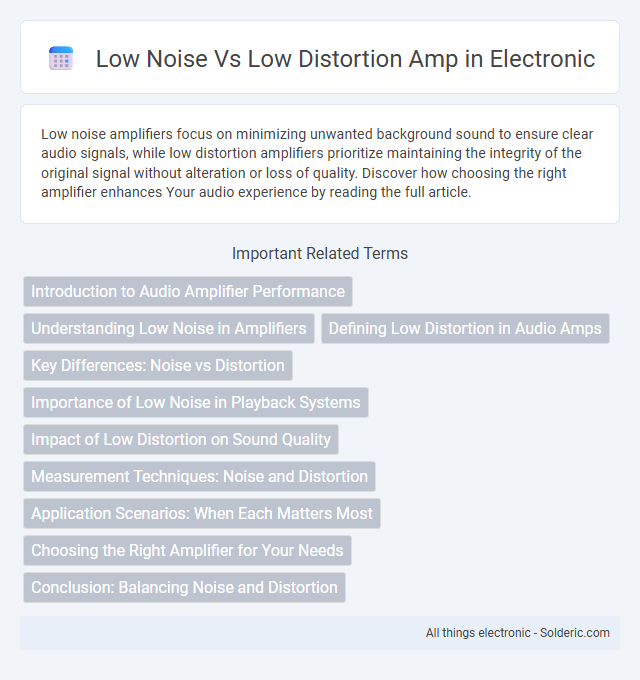Low noise amplifiers focus on minimizing unwanted background sound to ensure clear audio signals, while low distortion amplifiers prioritize maintaining the integrity of the original signal without alteration or loss of quality. Discover how choosing the right amplifier enhances Your audio experience by reading the full article.
Comparison Table
| Feature | Low Noise Amp | Low Distortion Amp |
|---|---|---|
| Primary Focus | Minimizing unwanted electrical noise | Reducing signal waveform distortion |
| Key Metric | Noise Figure (NF), Signal-to-Noise Ratio (SNR) | Total Harmonic Distortion (THD), Intermodulation Distortion (IMD) |
| Performance Impact | Improves clarity by reducing hiss and static | Preserves original audio or signal integrity |
| Use Case | High-sensitivity audio recording, RF front ends | High-fidelity audio systems, precision instrumentation |
| Design Considerations | Low-noise transistors, careful shielding | Linear amplification, feedback control |
| Typical Application | Microphone preamps, radio receivers | Hi-Fi amplifiers, measurement devices |
Introduction to Audio Amplifier Performance
Low noise and low distortion are critical performance metrics in audio amplifiers that directly affect sound quality and fidelity. Noise refers to unwanted electrical signals that can mask subtle audio details, while distortion alters the original signal's waveform, resulting in inaccurate sound reproduction. Evaluating these parameters ensures amplifiers deliver clear, precise audio with minimal interference and faithful signal amplification.
Understanding Low Noise in Amplifiers
Low noise in amplifiers refers to the minimal unwanted electrical interference that can obscure the desired audio or signal output, critical for maintaining clarity in high-fidelity sound systems. It is quantified by the noise figure or noise voltage, with lower values indicating superior amplifier performance in preserving signal integrity. Unlike low distortion amplifiers that focus on reducing signal waveform alterations, low noise amplifiers prioritize minimizing the background noise floor to enhance the overall signal-to-noise ratio (SNR).
Defining Low Distortion in Audio Amps
Low distortion in audio amps refers to the minimal alteration of the original audio signal, ensuring that the output sound remains true to the source without unwanted harmonic or intermodulation distortion. Distortion levels are typically measured as Total Harmonic Distortion (THD), with values below 0.1% considered excellent for high-fidelity amplifiers. Your choice between low noise and low distortion amps depends on whether you prioritize clarity free from background hiss or faithful reproduction of nuanced audio details.
Key Differences: Noise vs Distortion
Low noise amplifiers prioritize minimizing unwanted background sounds or hiss, ensuring cleaner audio signals with less audible interference. Low distortion amplifiers focus on reducing signal alteration or harmonic changes, preserving the original sound quality without added coloration. Your choice depends on whether clarity from noise or fidelity without signal modification is more critical for your audio setup.
Importance of Low Noise in Playback Systems
Low noise is crucial in playback systems because it preserves the clarity and detail of the original audio signal, ensuring a clean listening experience without unwanted hiss or background sounds. Low noise amplifiers prevent masking subtle nuances in music or dialogue, allowing your playback system to deliver true sonic fidelity. While low distortion maintains signal accuracy, minimizing noise directly impacts the overall sound quality and listener satisfaction.
Impact of Low Distortion on Sound Quality
Low distortion amplifiers preserve the original audio signal by minimizing harmonic and intermodulation distortions, resulting in clearer and more accurate sound reproduction. This enhances your listening experience by ensuring that instruments and vocals retain their natural timbre and detail. While low noise reduces background hiss, low distortion directly impacts sound quality by maintaining the purity and integrity of the audio output.
Measurement Techniques: Noise and Distortion
Measuring low noise in amplifiers involves using a spectrum analyzer to detect and quantify the background noise floor, often expressed in microvolts or decibels relative to the signal level, while ensuring the input signal is minimized to isolate intrinsic noise. Low distortion measurement relies on analyzing harmonic distortion components using tools like a distortion analyzer or a frequency response analyzer, focusing on Total Harmonic Distortion (THD) percentages to assess signal fidelity. These techniques enable you to accurately evaluate amplifier performance, prioritizing either noise reduction or minimal harmonic distortion based on your application needs.
Application Scenarios: When Each Matters Most
Low noise amplifiers are essential in sensitive audio recording and radio frequency applications where preserving signal integrity without background hiss is critical. Low distortion amplifiers excel in high-fidelity audio playback and musical instrument amplification, ensuring accurate sound reproduction with minimal harmonic or intermodulation distortion. Choosing between the two depends on specific needs: low noise for clean signal capture and low distortion for precise sound output.
Choosing the Right Amplifier for Your Needs
Low noise amplifiers are essential for applications requiring clean audio signals, minimizing background hiss and preserving sound clarity, particularly in sensitive recording environments or high-fidelity audio systems. Low distortion amplifiers prioritize maintaining signal integrity by reducing harmonic and intermodulation distortions, making them ideal for professional audio production and accurate sound reproduction. Selecting the right amplifier depends on prioritizing noise performance for quiet environments or distortion control for precision, aligning with specific audio requirements and usage contexts.
Conclusion: Balancing Noise and Distortion
Balancing noise and distortion in audio amplifiers requires prioritizing the listening environment and application, as low noise amps minimize background hiss while low distortion amps preserve signal accuracy. High-fidelity audio systems often demand a combination of ultra-low noise floors and minimal harmonic distortion for optimal sound clarity. Selecting the appropriate amplifier depends on whether reducing audible noise or maintaining signal integrity is most critical.
Low noise vs Low distortion amp Infographic

 solderic.com
solderic.com